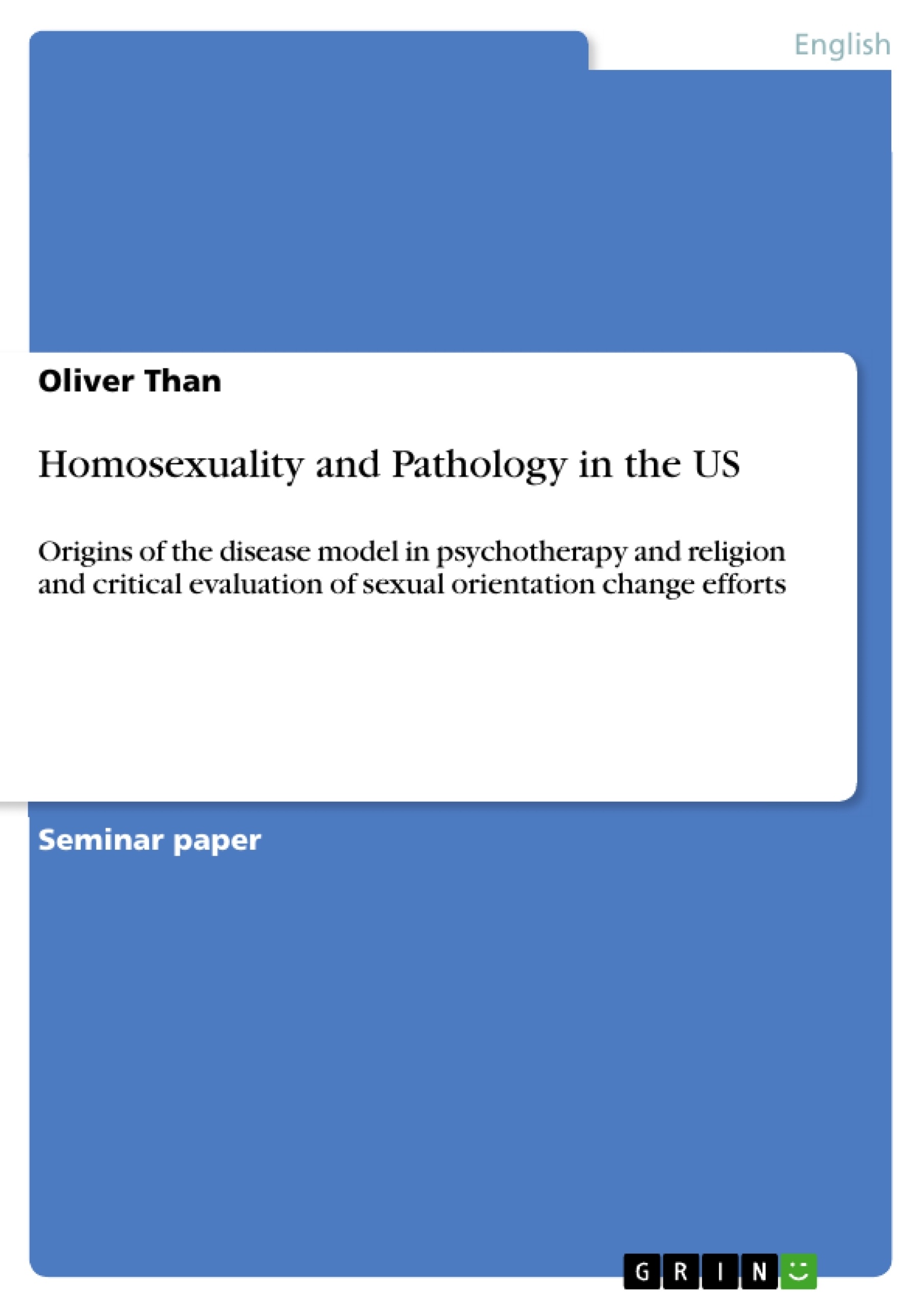For almost four decades now organized mental health has declassified
homosexuality as a mental illness in the United States of America. After several years of bitter dispute, the American Psychiatric Association decided to remove homosexuality as a mental disorder from the Diagnostic and Statistical Manual of Psychiatric Disorders, its official list of mental diseases. Nevertheless it is remarkable that a demise of therapies designed to change homosexual orientation seems improbable at least, given that some religious political activists and marginalized health professionals are apparently seeking to reinstate the disease-model of homosexuality by presenting stories of presumably cured homosexuals to the American public. Aside the professional media, especially religious
groups promoting sexual orientation change therapies recently
experienced unwanted popular media coverage.The treatment of homosexualityby medical practitioners is of relatively recent origin. Before 1800, homosexuality was essentially conceived as
a merely theological-moral phenomenon. From then onward however,
legislative declared it a legal matter until medical professionals declared it a sickness. While at it’s time of origin, the medical practitioners’ concept of homosexuality as a sickness may have been a liberal and humaneadvance over the conception and punishment of homosexuality as a crime, at the latest since the post World-War II years, psychiatrists andpsychologists can be regarded among the major ideologues of homosexual oppression. Sexual conversion therapies or reparative therapies derive from this
disease model portraying homosexuality as a mental disorder and a social evil. Since these terms in my opinion inaccurately imply defectiveness in homosexuality and bisexuality, I chose to refer to such therapy as sexual orientation change efforts in the title of this paper. Today the main groups pursuing these kinds of therapies are the before-mentioned marginalized psychotherapists and conservative Christians. This paper will consecutively show that this kind of therapy should not in any way be influential to the
development of public policy since the very origins of the disease model are based on badly flawed assumptions. It will subsequently critically evaluate sexual orientation change efforts in general, addressing several issues as its effectiveness, potential harmfulness and its effect on the public view of lesbian, gay and bisexual people.
Inhaltsverzeichnis (Table of Contents)
- Introduction
- Body
- The disease model of homosexuality: origins in psychoanalytic theory and religion
- Homosexuality and the psychoanalytic establishment
- Homosexuality and right-wing Christians
- Sexual orientation change efforts - a critical evaluation
- Internalized homophobia - a sufficient reason for therapy?
- Effectiveness of sexual orientation change efforts
- Potential harmfulness of sexual orientation change efforts
- Sexual orientation change efforts and its effect on the public views of lesbian, gay and bisexual people
- The disease model of homosexuality: origins in psychoanalytic theory and religion
Zielsetzung und Themenschwerpunkte (Objectives and Key Themes)
This paper aims to critically evaluate sexual orientation change efforts, also known as conversion therapies, in the United States. It delves into the historical context of the disease model of homosexuality, tracing its roots in both psychoanalytic theory and religious beliefs. The paper examines the motivations behind these therapies, their potential effectiveness, and the potential harm they can cause to individuals and society. It also addresses the impact of these therapies on public perceptions of lesbian, gay, and bisexual people.
- The historical origins and evolution of the disease model of homosexuality
- The role of psychoanalytic theory and religion in shaping attitudes towards homosexuality
- The motivations behind sexual orientation change efforts, including political, religious, and economic factors
- The effectiveness and potential harmfulness of sexual orientation change efforts
- The impact of these efforts on public perceptions of lesbian, gay, and bisexual people
Zusammenfassung der Kapitel (Chapter Summaries)
- Introduction: This chapter provides an overview of the historical context surrounding the classification and treatment of homosexuality in the United States, highlighting the declassification of homosexuality as a mental illness in 1973 and the ongoing efforts by some groups to reinstate the disease model. It introduces the concept of sexual orientation change efforts and the paper's focus on critically evaluating their effectiveness, potential harm, and social implications.
- The disease model of homosexuality: origins in psychoanalytic theory and religion: This chapter explores the shared origins of the disease model of homosexuality in both psychoanalytic theory and religious beliefs. It examines the influence of prominent psychoanalytic figures and their contributions to the pathologization of homosexuality. The chapter also discusses the role of right-wing Christians in promoting the disease model and pushing for sexual orientation change efforts.
- Sexual orientation change efforts - a critical evaluation: This section critically examines sexual orientation change efforts from various angles. It addresses the validity of using internalized homophobia as a justification for therapy, evaluates the effectiveness of these efforts, and explores their potential harmfulness to individuals. The chapter concludes by discussing the impact of these efforts on public perceptions of lesbian, gay, and bisexual people.
Schlüsselwörter (Keywords)
This paper focuses on the intersection of homosexuality, pathology, and the disease model, specifically in the context of the United States. Key concepts include: sexual orientation change efforts (conversion therapy), psychoanalytic theory, religion, internalized homophobia, effectiveness, harmfulness, and public perception.
- Quote paper
- Oliver Than (Author), 2010, Homosexuality and Pathology in the US , Munich, GRIN Verlag, https://www.grin.com/document/155795



